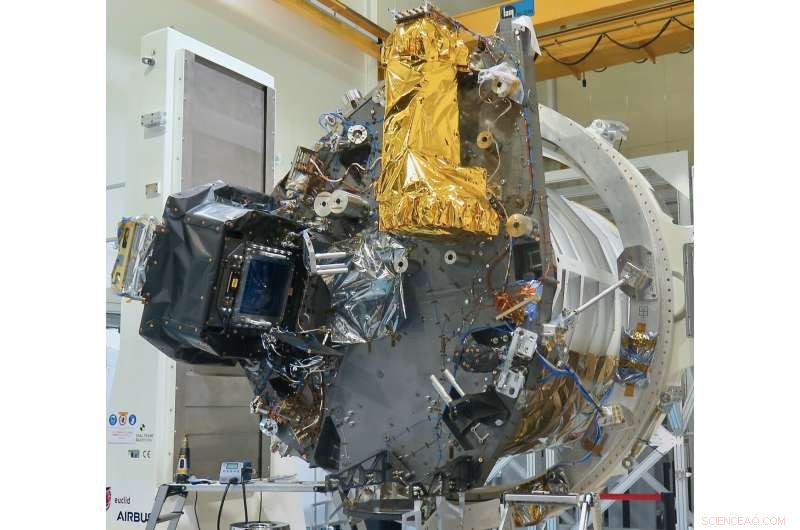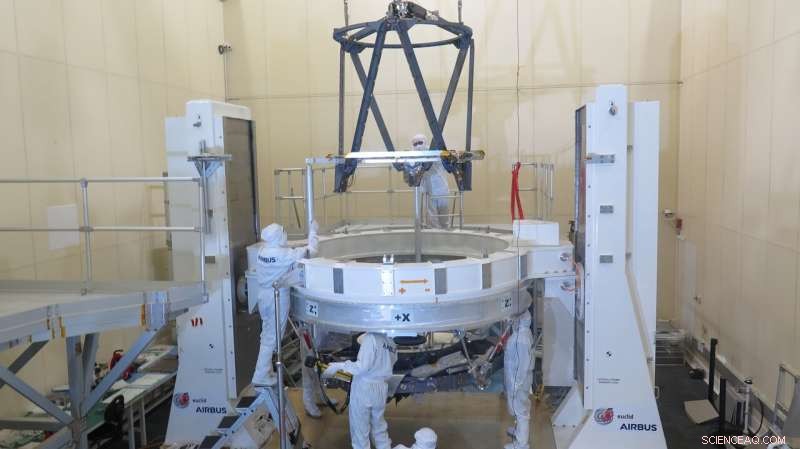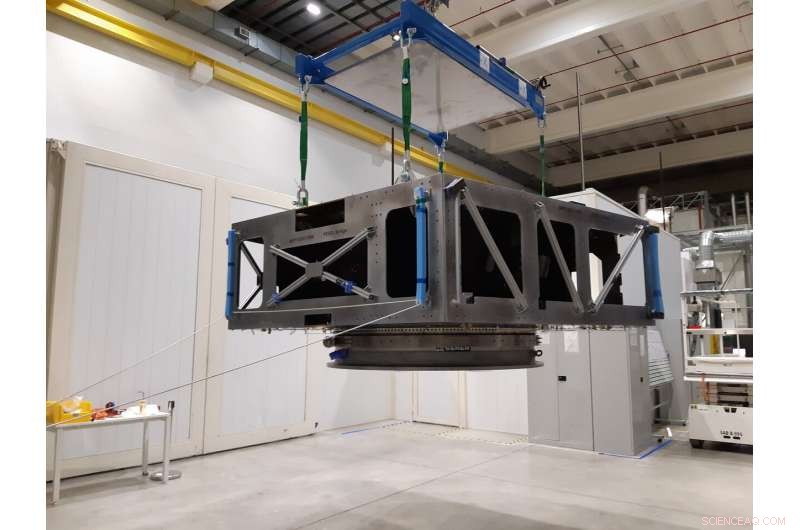 p Os instrumentos VIS e NISP no módulo de carga útil do Euclid. Crédito:Airbus
p Os instrumentos VIS e NISP no módulo de carga útil do Euclid. Crédito:Airbus
p A missão Euclides da ESA atingiu outro marco na sua jornada para o lançamento. Seus dois instrumentos agora estão construídos e totalmente testados. Estes foram entregues à Airbus Defense and Space em Toulouse, França, onde eles agora estão sendo integrados com o telescópio para formar o módulo de carga útil da missão. p O Euclid consiste em um telescópio de espelho de 1,2 metros projetado para trabalhar em comprimentos de onda visível e infravermelho - este último sendo apenas mais longo do que a luz vermelha que os humanos podem ver. O telescópio irá coletar luz de objetos cósmicos distantes e alimentá-la em dois instrumentos.
p O instrumento Visível (VIS) e o Espectrômetro de Infravermelho Próximo e Fotômetro (NISP) funcionarão em paralelo, registrando dados simultaneamente de qualquer parte do céu para a qual o telescópio esteja apontado.
p A missão de Euclides é medir as formas de mais de um bilhão de galáxias, e os redshifts precisos de dezenas de milhões de galáxias em mais de um terço do céu. O redshift é um efeito causado pela expansão do Universo. Ele estende o comprimento de onda da luz emitida por galáxias distantes; quanto mais longe a galáxia, o mais extremo é o seu desvio para o vermelho. As galáxias na pesquisa de Euclides abrangerão 10 bilhões de anos de história cósmica, e permitir que os cientistas investiguem a misteriosa matéria escura e a energia escura que supostamente dominam o Universo.
p O instrumento VIS realizará a medição precisa das formas das galáxias, obtendo as melhores imagens de galáxias distantes que puder. Para fazer isso, o instrumento usa um mosaico de 36 CCDs, cada um dos quais contém 4000 pixels por 4000 pixels. Isso dá ao detector um total de cerca de 600 megapixels.
p "O design, desenvolvimento, fabricação, testar e calibrar o instrumento VIS ao longo de uma dúzia de anos para uma especificação rigorosa tem sido um desafio, "diz Mark Cropper, VIS instrumento líder e professor do Laboratório de Ciências Espaciais da UCL Mullard, REINO UNIDO.
p "Estamos imensamente orgulhosos do que a equipe do VIS alcançou para levar este projeto ao seu ponto culminante. O fato de o desempenho final exceder as nossas expectativas é um tributo à sua experiência, dedicação e profissionalismo. "
p Não é apenas o número de pixels impressionante, o instrumento também fornecerá a melhor sensibilidade à baixa luminosidade em uma ampla faixa de comprimentos de onda em longos tempos de integração.
Animação Euclides - visão de 360 graus. Crédito:ESA / ATG medialab p "Estes são CCDs muito especiais, eles foram desenvolvidos especificamente para Euclides ao longo de muitos anos, "diz Alex Short, Engenheiro de carga do VIS da ESA.
p O outro instrumento, NISP, dedica-se a fazer medições espectroscópicas de galáxias, que envolve a divisão de sua luz em comprimentos de onda individuais. Isso permite que os desvios para o vermelho sejam deduzidos. Esta propriedade permite aos cosmologistas estimar a distância até a galáxia em questão, e permitirá que os dados de Euclides sejam transformados no maior, a pesquisa 3-D mais precisa do Universo já realizada.
p "A equipe internacional do NISP e as indústrias de apoio fizeram um trabalho incrível de design, desenvolver e testar este instrumento desafiador, "diz Thierry Maciaszek, Gerente de projeto de instrumento NISP, do CNES e Laboratoire d'Astrophysique de Marseille, França.
p "Isto é, Contudo, não é o fim da história para nós, já que muitas atividades importantes devem ser concluídas com o NISP em nível de satélite. Estamos esperando impacientemente pela primeira luz em vôo demonstrando o excelente desempenho global. "
p O detector NISP apresentará o maior campo de visão já voado no espaço para um instrumento infravermelho.
p "A qualidade da ótica é simplesmente incrível, "diz Tobias Boenke, Engenheiro de Sistema de Missão e Instrumento NISP na ESA.
p Um fator chave para alcançar a precisão óptica excepcional de Euclid foi uma decisão tomada no início da história do projeto de construir todo o módulo de carga útil de carboneto de silício. A utilização deste material na ESA foi pioneira na fabricação do telescópio para a missão espacial Herschel. Na missão Gaia da ESA, a estrutura de suporte para os subsistemas da espaçonave foi montada em uma estrutura de carboneto de silício. Em Euclides, o material foi usado para os instrumentos e também para o telescópio.
p Considerando que o metal se expande e se contrai conforme sua temperatura muda, degradando assim a capacidade de um sistema óptico de focar a luz, o carboneto de silício é extremamente estável a tais variações de temperatura. Mas usar o composto traz seus próprios desafios. O carboneto de silício é uma cerâmica e muito mais frágil que o metal.
 p The supporting structure of the telescope’s secondary mirror for ESA’s Euclid spacecraft being brought together for final integration and optical alignment at Airbus in Toulouse, França. Crédito:Airbus
p The supporting structure of the telescope’s secondary mirror for ESA’s Euclid spacecraft being brought together for final integration and optical alignment at Airbus in Toulouse, França. Crédito:Airbus
p "It was a big challenge to be able to manufacture the instruments from this material and make sure they can remain undamaged during the launch, " adds Tobias.
p Like VIS, NISP also uses specially designed state-of-the-art detectors to record the faint light coming from distant stars and galaxies. Unlike VIS, NISP can also operate in spectrographic mode. The detectors, which are operated at –180°C to provide ultra-low noise and high sensitivity, register these 'spectra' and convert them into tiny electronic signals. These signals can then be amplified and accurately measured to provide the photometric and spectroscopic redshifts.
p The instruments will receive light from Euclid's telescope, which has already been assembled at Airbus, Toulouse. Like the instruments, it too is made from silicon carbide and is a state-of-the art construction in all senses.
p "We are pushing all the manufacturing levels to the limit, " says Luis Miguel Gaspar Venancio, ESA's Mission Performance &Optical Systems Engineer.
p A special component behind the telescope, called the dichroic, separates the collected light and diverts the visible wavelengths to VIS and the infrared wavelengths to NISP.
p When the information from VIS and NISP is combined, scientists will be able to deduce the way that the Universe's large-scale distribution of galactic structures has built up throughout cosmic history. This will help them determine the speed at which such structures grow, providing strong constraints on the nature and amount of dark matter and dark energy in the Universe.
p The instruments were prepared for delivery to Airbus just before the COVID-19 pandemic imposed restrictions and lockdowns in many ESA member states. Felizmente, VIS was already at Airbus, and NISP had to wait for a few weeks for shipment from Marseille to Toulouse, but was not on the critical path.
p "I am extremely grateful to all project parties:institutes, industry and colleagues at ESA for their dedication and commitment during these difficult times, " says Giuseppe Racca, ESA's Euclid project manager.
 p The flight model of ESA’s Euclid mission’s service module being moved in the clean room at Thales Alenia Space in Torino, Itália. Credit:Thales Alenia Space Italy
p The flight model of ESA’s Euclid mission’s service module being moved in the clean room at Thales Alenia Space in Torino, Itália. Credit:Thales Alenia Space Italy
p "We were hit by the pandemic in a particularly critical moment when both VIS and NISP were to be transferred to industry. Despite the work and travel restrictions a concerted effort by all parties allowed to minimize the delays by implementing distributed and sequential integration activities of the instrument units and remote monitoring."
p Now that the instruments have been delivered to Airbus, they will be integrated first with the telescope, and next with the rest of the payload module. It has been a long journey getting this far. Euclid was selected for implementation in 2011, having already undergone almost five years of studies. While there is still a lot of hard work and testing ahead, the delivery of the instruments and telescope means that the spacecraft can really begin to come together.
p "Finalmente, we have something in front of our eyes, " says Luis Miguel. "It's not just paper anymore. It's a fantastic piece of hardware; beautiful in a way."
p Integrating the payload module will last several months as it is painstaking work to get everything bolted together, precisely aligned and electronically talking. The instrument's control units have already been mechanically and electrically integrated to the payload module. These tests have verified that the instruments can be properly powered by the spacecraft, can talk to the onboard computers, and can transmit the science data that will then be downloaded to ground through the spacecraft antennas.
p Once the telescope has been integrated with the rest of the payload module, it will be shipped to Centre Spatial de Liège, Bélgica, for 'end-to-end' testing in a thermal vacuum chamber that can simulate the conditions of space as well as possible on Earth. This test is scheduled to take place in February and March 2021.
p Once that test shows that everything is working as expected, the payload module will be shipped to the prime contractor Thales Alenia Space (TAS), in Torino, Itália. TAS has been building the service module, which contains essential systems such as power, propulsion and communications.
p The service module's main structure recently passed its structural and thermal tests and is now ready to have the various systems integrated inside. TAS will begin by laying down the pipelines for the propulsion systems, and the cabling for other distributed systems. Flight electronics, incluindo computadores, power units, and attitude control units, are already mounted on their own structural panels and these will now be installed inside the main structure. Integration is due to be complete in the third quarter of the year, at which time tests will be performed.
p TAS will then integrate the payload module with the service module to form the final, finished spacecraft. Então, another round of tests will ensure that everything is working together properly. Nesse ponto, the spacecraft is essentially finished, and ready for launch.
p Launch is currently scheduled for the second half of 2022 from Europe's spaceport, Kourou, Guiana Francesa.


